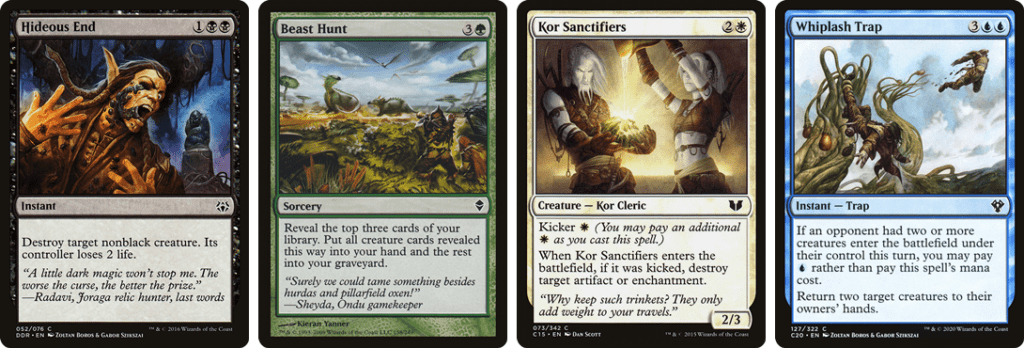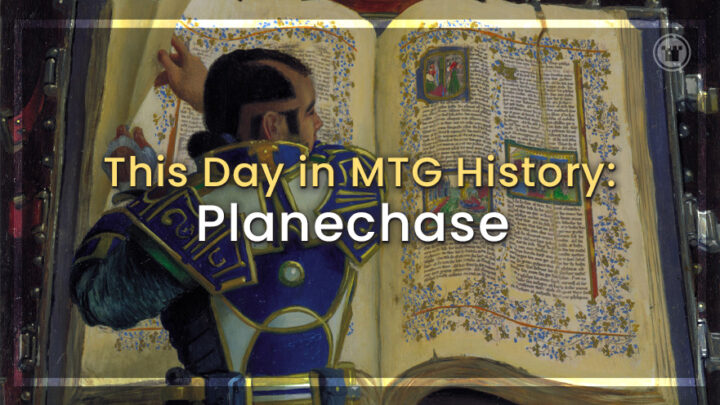Welcome back to another edition of “This Day in Magic History.” Today, we’re going to look at the release of Planechase, which had its release events from Sept. 4-6, 2009. Planechase isn’t especially well-known these days, but it marked a number of important Magic firsts: it was the first supplemental set, the first set focused on multiplayer, the first set focused on casual play and the first set to invent a brand new Magic format.
The Development of Planechase
The genesis of this unique product can largely be attributed to Elaine Chase. Chase was Wizards of the Coast’s senior brand manager (and eventually director) from in 2009. She wanted R&D to work on a product and new format that appealed to the multiplayer and casual crowds, as the company had really never attempted anything like that had really been attempted. In particular, Elaine wanted the team to create an official Magic product modeled after a casual player-made format called “Chaos Magic.”
Chaos Magic is a free-for-all multiplayer format that was quite popular in 2009. This meant that there were no teams, and all players could attack any other player. It also featured a “Chaos Deck,” which players drew from at the beginning of each turn cycle. That card would have some effect until a new one replaced it, and they were all just regular Magic cards. However, each of them was assigned some sort of global effect before the game began.
So, the goal with Planechase was to create a free-for-all multiplayer format where each turn felt like a unique experience as a result of a global effect. Ultimately, it was Aaron Forsythe, the design director at the time, who came up with the main premise of Planechase.
It became a format that would simulate what it was like to be a planeswalker, moving from plane to plane during each turn cycle. Each plane would have its own effects on the game. This was a great way to create an on-brand and in-universe version of Chaos Magic.
The Product
Planechase consisted of four preconstructed decks. The idea was that people could simply buy these decks, shuffle them and then play a game in the Planechase format. In addition to your typical 60-card Magic deck, each Planechase deck also contained a 10-card, oversized planar deck and a special planar die.
These played a central role in the new format by causing players to randomly travel to each of these new planes. Apart from the planar decks, the preconstructed decks were entirely made up of reprints, with one notable exception! Each of the decks featured one Common card from Zendikar, a set that hadn’t even been released. This was a unique and fun way to kick off preview season for the next set.

The Planechase Format
So, how exactly does this Planechase format work? Well, it was largely like any free-for-all multiplayer game of Magic, with the only difference being the effect of plane cards on the game. Like with Chaos Magic, the first player of each turn cycle drew a card from a special deck and put it into play. In this case, it was cards featuring the “Plane” type. These planes would have some kind of global effect. For example “Tazeem” kept creatures from blocking.
So far, what I’ve explained sounds much like Chaos Magic, apart from the fact that these planar cards were unique and specially designed for the format. However, there was one big difference, and that was the planar die.
Any time a player could cast a sorcery, and once per turn, they could roll the planar die. This six-sided die features four blank faces, one face with the planeswalker symbol and one face with a “chaos” symbol. If a player landed on the planeswalker symbol, this would allow them to remove the plane that was in play and draw a new planar card that would replace it.
The chaos symbol had a unique (and usually powerful) effect depending on what plane card was in play. For example, if Tazeem was in play, a player who rolled the chaos symbol would draw a card for each land they controlled.
Later Planechase Products
Planechase was largely a success in 2009, and as a result there were some follow-up products. This included Planechase 2012 and 2016’s Planechase Anthology. Planechase 2012 featured four, new, 60-card decks and new 10-card planar decks. Unlike the original Planechase, Planechase 2012 also featured some new cards. Most notably, Baleful Strix actually received its first printing in Planechase 2012, and it is a card that has gone on to be a historically powerful card in Legacy.
2016’s Planechase Anthology, however didn’t feature any new cards. Instead, it contained all of the preconstructed decks released in Planechase and Planechase 2012.
End Step
Ultimately, Planechase largely died out as a format. This was partly a result of the proliferation of Commander, which kicked into overdrive after Wizards of the Coast created its first preconstructed decks for that format in 2011.
Commander quickly became the preferred format of the same type of player who enjoyed Planechase. However, keep in mind that by the time 2011 and those first precons rolled around, Wizards of the Coast only had experience creating a product targeted at a multiplayer casual format thanks to Planechase!

Jacob has been playing Magic for the better part of 24 years, and he especially loves playing Magic’s Limited formats. He also holds a PhD in history from the University of Oklahoma. In 2015, he started his YouTube channel, “Nizzahon Magic,” where he combines his interests with many videos covering Magic’s competitive history. When he’s not playing Magic or making Magic content, he can be found teaching college-level history courses or caring for a menagerie of pets with his wife.


